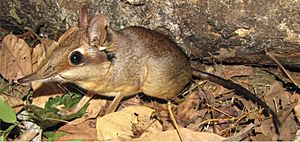Four-toed elephant shrew facts for kids
Quick facts for kids Four-toed elephant shrew |
|
|---|---|
 |
|
| Conservation status | |
| Scientific classification | |
| Genus: |
Petrodromus
|
| Species: |
tetradactylus
|
 |
|
| Four-toed elephant shrew range | |
The four-toed elephant shrew or four-toed sengi (Petrodromus tetradactylus) is a unique small mammal. It's the only living species in its group, called Petrodromus. This animal is part of a larger family of elephant shrews, which are known for their long, flexible snouts, similar to an elephant's trunk.
As its name suggests, the four-toed elephant shrew has four toes on its back feet. These interesting creatures are found only in certain parts of Africa. They are smaller than some of their relatives and are quite special!
Contents
Where They Live and What They Like
The four-toed elephant shrew lives in Central and Southern East Africa. You can find them in countries like Angola, Democratic Republic of the Congo, Kenya, Malawi, Mozambique, South Africa, Tanzania, Zambia, Zimbabwe, and possibly Namibia.
They love places with lots of trees and plants. Their favorite homes are dry forests, montane forests (forests on mountains), and wet savannas. They especially like dense forests and thick bushes where they can find good cover and protection. They also need plenty of invertebrates to eat. At night, they prefer to sleep under thick bushes instead of building a nest.
Even though their homes are sometimes destroyed and they are hunted in some areas, the four-toed elephant shrew is not currently in danger of disappearing. Their conservation status is listed as "least concern," which is good news!
What They Look Like
A four-toed elephant shrew has soft, long fur. Its color can be light brownish-grey or dark brown. They have white rings around their eyes and dark stripes on their backs.
Their feet are brownish-yellow on top, and their ears are dark brown with white hair inside. Their tail is black on top and light yellow-brown underneath, getting darker towards the tip.
One of their most noticeable features is their long, pointed, and flexible snout. They use this sensitive snout to hunt for food. They also have short front legs and long back legs, which help them move quickly.
Compared to other elephant shrews, the four-toed elephant shrew has bigger, upright ears and large eyes. While other elephant shrews can vary a lot in size (from about 10 to 30 cm (4 to 12 in) long), the four-toed elephant shrew is usually between 19 to 23 cm (7.5 to 9 in) long. Their tail is typically 15.5 to 17 cm (6.1 to 6.7 in) long.
These shrews are also quite large for an elephant shrew, weighing between 160 and 280 g (5.6 and 9.9 oz).
How They Behave
Four-toed elephant shrews are usually active during the day and early evening. They tend to rest during the night or in the middle of the day. When they run, their tail points upwards! They also make a special noise with their back feet. This sound helps them find Ants and other prey.
When two four-toed elephant shrews fight, they usually do it in pairs of the same gender. They "box" each other, standing on their back legs and using their front legs to push and tackle. They have excellent senses of sight, smell, and hearing. However, they don't make many different sounds. When they are kept in captivity, they might scream, purr, or cluck if they need help.
What They Eat
Four-toed elephant shrews rely a lot on rich leaf litter for their food and for building nests. Their main food source is small invertebrates. They especially love Ants and termites. They also eat crickets, grasshoppers, spiders, centipedes, millipedes, and earthworms. Sometimes, they will also eat seeds, fruits, buds, and other plant parts. They eat a bit like anteaters, flicking small food items into their mouths with their long snouts.
Their diet can change depending on where they live. For example, in Kenya, their meals often include termites, plant matter, centipedes, ants, crickets, cockroaches, millipedes, and spiders.
Some animals that hunt four-toed shrews include snakes, raptors (like eagles and hawks), and other carnivores. Sometimes, even domestic cats might hunt them.
Reproduction and Life Cycle
Four-toed elephant shrews can breed all year round, especially when there is plenty of food available. The lowland forests and savannas provide safe places to rest, hide from the midday heat, and give birth.
A mother four-toed elephant shrew is pregnant for about 40 to 60 days. She usually gives birth to one or two babies. The young are born quite developed and are ready to be weaned (stop drinking milk from their mother) after about 15 to 25 days.


